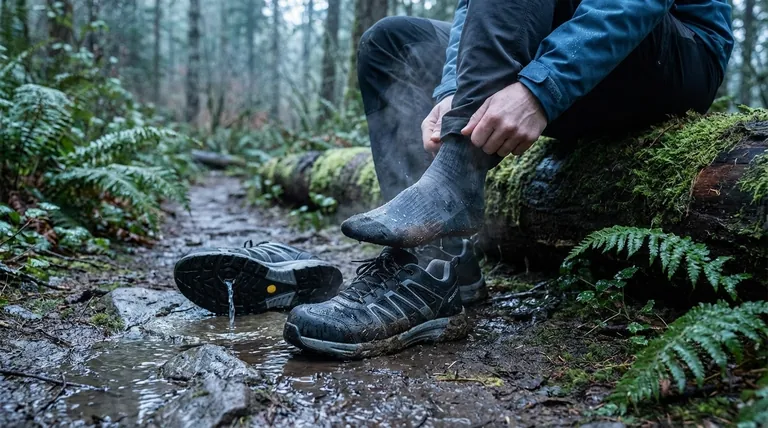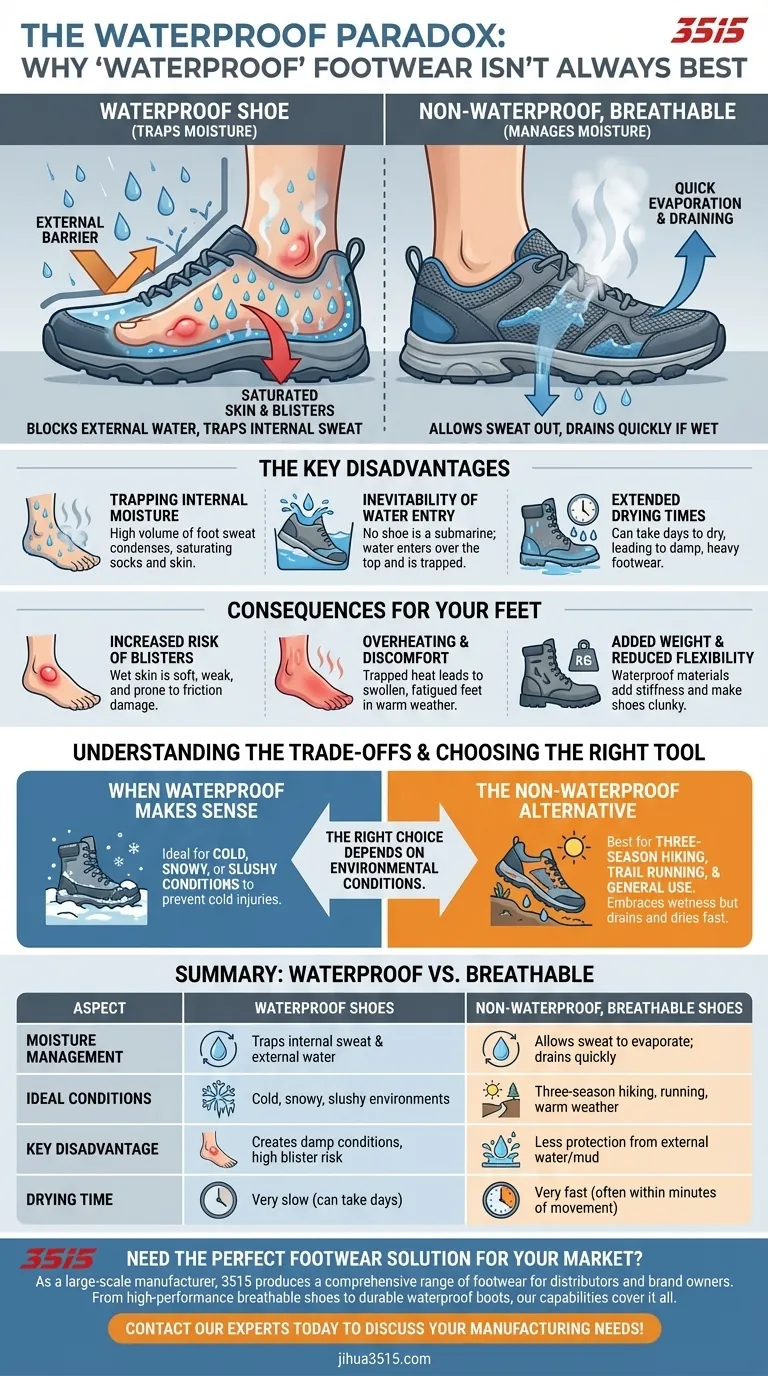The primary reason for advising against waterproof shoes is their fundamental trade-off: in blocking external water, they also trap internal moisture from sweat. This lack of breathability often creates the very damp conditions and foot problems—like blisters—that users are trying to prevent, especially in moderate to warm weather.
The critical flaw in most waterproof footwear is its inability to manage moisture effectively. While they excel at blocking water from entering, they simultaneously create a miniature swamp by trapping the sweat your feet naturally produce, leading to saturated skin that is weak and prone to friction.

The Paradox of "Waterproof" Footwear
The concept of a truly "waterproof" yet "breathable" shoe is an engineering challenge. The reality is that the membrane designed to keep water out almost always compromises the shoe's ability to let water vapor out.
Trapping Internal Moisture
Your feet are one of the sweatiest parts of your body. In a non-waterproof shoe, this moisture evaporates through the mesh upper, keeping your foot relatively dry.
A waterproof membrane, however, cannot transport this high volume of vapor away quickly enough. The sweat condenses inside your shoe, saturating your sock and skin.
The Inevitability of Water Entry
No shoe is a submarine. During heavy rain or when crossing a stream, water will inevitably enter over the top of the shoe.
Once water gets inside a waterproof shoe, it is trapped. The same membrane that prevents water from getting in also prevents it from getting out, turning your shoe into a bucket that can hold water for miles.
Extended Drying Times
A non-waterproof, breathable mesh shoe will drain almost instantly and can begin to dry from your body heat and airflow as you move.
In contrast, a waterproof shoe that has been swamped can take days to dry completely, as it has no effective way to drain or allow for evaporation.
The Consequences for Your Feet
This trapped moisture, whether from sweat or external sources, has direct, negative consequences for foot health and comfort during any activity.
Increased Risk of Blisters
Wet skin is significantly softer, weaker, and more susceptible to damage from friction. The constant dampness inside a waterproof shoe creates the perfect environment for hot spots and blisters to form.
Overheating and Discomfort
The lack of breathability means heat is also trapped. In warm weather, this quickly leads to uncomfortably hot, swollen, and sweaty feet, increasing overall fatigue and discomfort.
Added Weight and Reduced Flexibility
Waterproof materials and construction add stiffness and weight to a shoe. This can make them feel clunky and less responsive, which is particularly noticeable on long runs or hikes where every ounce matters.
Understanding the Trade-offs
The choice is not about "good" versus "bad" but about selecting the right tool for a specific environment. Acknowledging the limitations of waterproof technology is key.
When Waterproof Makes Sense
Waterproof footwear is the superior choice in cold, snowy, or slushy conditions.
In these environments, keeping external moisture out is critical to prevent dangerous cold-related injuries like frostbite. Your feet also sweat less in the cold, making the lack of breathability a less significant issue.
The Non-Waterproof Alternative
For the vast majority of three-season hiking, trail running, and general use, a non-waterproof, highly breathable shoe is far more effective.
These shoes work on the principle of moisture management, not moisture blocking. They embrace the fact that they will get wet, but they are engineered to drain and dry as quickly as possible.
Making the Right Choice for Your Activity
Your decision should be dictated by the environmental conditions you expect to face, not by a desire to keep your feet dry at all costs.
- If your primary focus is hiking or running in most three-season conditions: Choose non-waterproof, highly breathable shoes that drain and dry quickly.
- If your primary focus is activity in cold, snowy, or consistently wet and slushy environments: Waterproof footwear is the appropriate tool to protect against cold-related injuries.
Ultimately, managing moisture from the inside out is often more critical for foot health than blocking it from the outside in.
Summary Table:
| Aspect | Waterproof Shoes | Non-Waterproof, Breathable Shoes |
|---|---|---|
| Moisture Management | Traps internal sweat and external water | Allows sweat to evaporate; drains quickly if wet |
| Ideal Conditions | Cold, snowy, slushy environments | Three-season hiking, running, warm weather |
| Key Disadvantage | Creates damp conditions, high blister risk | Less protection from external water/mud |
| Drying Time | Very slow (can take days) | Very fast (often within minutes of movement) |
Need the perfect footwear solution for your market?
As a large-scale manufacturer, 3515 produces a comprehensive range of footwear for distributors, brand owners, and bulk clients. Whether you need high-performance breathable shoes for summer trails or durable waterproof boots for winter conditions, our production capabilities encompass all types of shoes and boots. Let us help you provide your customers with the right tool for the right environment.
Contact our experts today to discuss your manufacturing needs and elevate your product line!
Visual Guide

Related Products
- Premium KPU Athletic Safety Shoes for Wholesale
- Durable Rubber-Soled Utility Shoes for Wholesale & Custom Brand Manufacturing
- Wholesale Breathable Training Shoes Custom Athletic Footwear Manufacturer
- Wholesale Durable & Breathable Training Shoes for Custom Brands
- Premium Lightweight Safety Shoes for Wholesale & Bulk Orders
People Also Ask
- What should warehouse work shoes include for safety? Essential Features for All-Day Protection
- What are the conditions faced by employees in meatpacking and poultry slaughter plants? Navigating Pervasive Slip Hazards
- Why is slip resistance important in safety footwear? Prevent Costly Workplace Slips and Falls
- What are the EN ISO 20345 norms for safety shoes? A Guide to Choosing the Right Protection
- What materials are used in the construction of these boots? A Guide to Velour Leather, Textile & PU Soles



















